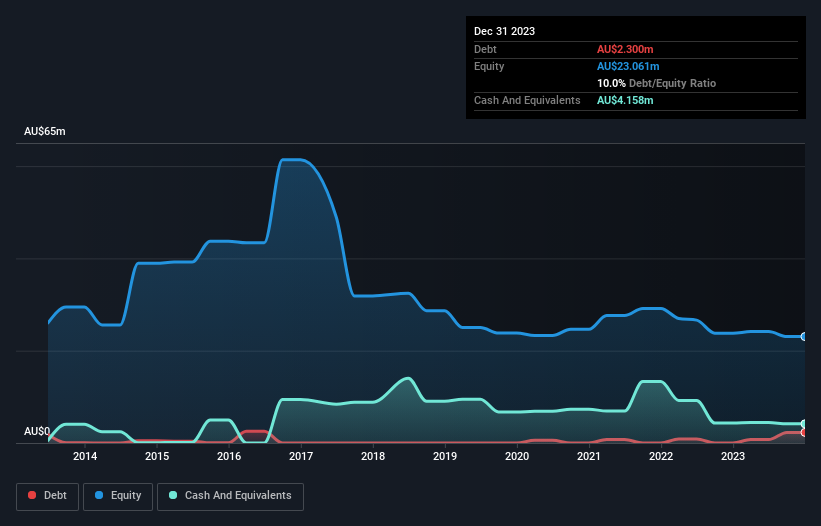
The external fund manager backed by Berkshire Hathaway's Charlie Munger, Li Lu, makes no bones about it when he says 'The biggest investment risk is not the volatility of prices, but whether you will suffer a permanent loss of capital.' When we think about how risky a company is, we always like to look at its use of debt, since debt overload can lead to ruin. We note that IDT Australia Limited (ASX:IDT) does have debt on its balance sheet. But the more important question is: how much risk is that debt creating?
Why Does Debt Bring Risk?
Debt and other liabilities become risky for a business when it cannot easily fulfill those obligations, either with free cash flow or by raising capital at an attractive price. If things get really bad, the lenders can take control of the business. While that is not too common, we often do see indebted companies permanently diluting shareholders because lenders force them to raise capital at a distressed price. Of course, debt can be an important tool in businesses, particularly capital heavy businesses. The first thing to do when considering how much debt a business uses is to look at its cash and debt together.
View our latest analysis for IDT Australia
How Much Debt Does IDT Australia Carry?
The image below, which you can click on for greater detail, shows that at December 2023 IDT Australia had debt of AU$2.30m, up from none in one year. But it also has AU$4.16m in cash to offset that, meaning it has AU$1.86m net cash.

How Healthy Is IDT Australia's Balance Sheet?
Zooming in on the latest balance sheet data, we can see that IDT Australia had liabilities of AU$3.22m due within 12 months and liabilities of AU$2.50m due beyond that. Offsetting these obligations, it had cash of AU$4.16m as well as receivables valued at AU$4.47m due within 12 months. So it actually has AU$2.91m more liquid assets than total liabilities.
This short term liquidity is a sign that IDT Australia could probably pay off its debt with ease, as its balance sheet is far from stretched. Succinctly put, IDT Australia boasts net cash, so it's fair to say it does not have a heavy debt load! When analysing debt levels, the balance sheet is the obvious place to start. But it is IDT Australia's earnings that will influence how the balance sheet holds up in the future. So if you're keen to discover more about its earnings, it might be worth checking out this graph of its long term earnings trend.
In the last year IDT Australia wasn't profitable at an EBIT level, but managed to grow its revenue by 72%, to AU$10m. With any luck the company will be able to grow its way to profitability.
So How Risky Is IDT Australia?
We have no doubt that loss making companies are, in general, riskier than profitable ones. And the fact is that over the last twelve months IDT Australia lost money at the earnings before interest and tax (EBIT) line. And over the same period it saw negative free cash outflow of AU$8.8m and booked a AU$6.5m accounting loss. Given it only has net cash of AU$1.86m, the company may need to raise more capital if it doesn't reach break-even soon. With very solid revenue growth in the last year, IDT Australia may be on a path to profitability. Pre-profit companies are often risky, but they can also offer great rewards. When analysing debt levels, the balance sheet is the obvious place to start. But ultimately, every company can contain risks that exist outside of the balance sheet. For example, we've discovered 4 warning signs for IDT Australia (2 are a bit concerning!) that you should be aware of before investing here.
If you're interested in investing in businesses that can grow profits without the burden of debt, then check out this free list of growing businesses that have net cash on the balance sheet.
New: AI Stock Screener & Alerts
Our new AI Stock Screener scans the market every day to uncover opportunities.
• Dividend Powerhouses (3%+ Yield)
• Undervalued Small Caps with Insider Buying
• High growth Tech and AI Companies
Or build your own from over 50 metrics.
Have feedback on this article? Concerned about the content? Get in touch with us directly. Alternatively, email editorial-team (at) simplywallst.com.
This article by Simply Wall St is general in nature. We provide commentary based on historical data and analyst forecasts only using an unbiased methodology and our articles are not intended to be financial advice. It does not constitute a recommendation to buy or sell any stock, and does not take account of your objectives, or your financial situation. We aim to bring you long-term focused analysis driven by fundamental data. Note that our analysis may not factor in the latest price-sensitive company announcements or qualitative material. Simply Wall St has no position in any stocks mentioned.
About ASX:IDT
IDT Australia
Engages in the research, development, manufacture, and sale of active pharmaceutical ingredients (API) and finished dose forms (FDF) products in Australia, Asia, Europe, and the Unites States.
Excellent balance sheet low.
Market Insights
Community Narratives




